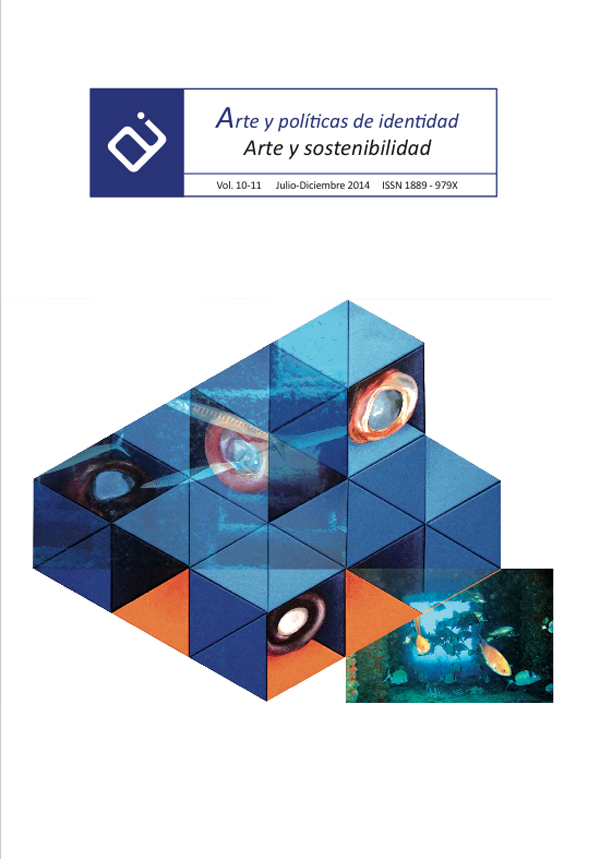Affinity with Objects and Values for Our Habitat: Revaluation of the Object and Disused Materials in Contemporary Art and Design
Abstract
The consequences for post-industrialism generate a paradigm change, greater awareness of nature, rational use of resources, rescue of articles intended for their disappearance and return to the values of human coexistence. Intended aim is to integrate these factors in contemporary creative sensibilities, and the challenges of an inordinate and destructive society. The methodology of the theoretical approach of these principles to guide a series of recent cases aimed at this growing sensitivity to our habitat, widely understood. In this sense, the cases offer a comprehensive view of this trend, including an own project in this regard. This habitat would include the natural and urban heritage, human behavior and conservation of objects, materials and goods into disuse but inspire our vision of contemporary art and culture.Downloads
-
Abstract495
-
PDF (Español (España))395
References
Alberti, L. B. (2007). De la pintura y otros escritos sobre arte. Madrid: Tecnos.
Azúa, M. (2011). Del producto al objeto. Por una revalorización del entorno material. En Temas de Diseño: Diseño en el siglo XXI. La forma del futuro, 27. Barcelona: Elisava.
Bachelard, G. (1993). La poética del espacio. México: Fondo de Cultura Económica.
Berthoz, A. (2012). Simplexity. Simplifying Principles for a Complex World. New Haven: Yale University Press.
Costa, J. (2007). Diseñar para los ojos. Barcelona: Costa Punto Com.
Callahan, T. Introducing the Chromatic Typerwriter! www.tyreecallahan.blogspot.com (07.04.2014)
Chavez, J. D. (2011). La dimensión poética de lo natural. En Corporación Patrimonio y Paisaje. http://patrimonioypaisaje.blogspot.com.es/2011/04/la-dimension-poetica-de-lo-natural.html (22.04.2014)
Duque, F. (2008). Habitar la tierra: medio ambiente, humanismo ciudad. Madrid: Akal.
Duque, F. (2001). Arte público y espacio político. Madrid: Tecnos.
Flusser, V. (2002). Filosofía del diseño: la forma de las cosas. Madrid: Síntesis.
García-Garrido, S. (2014). Elogio de la Lengua Española y las Artes del Libro. Tipometrías. Málaga: I+Diseño.
García-Garrido, S. (2007). Diseño contra contaminación visual, Sevilla: aad/Universidad Internacional de Andalucía.Libro de Acuerdo de la Junta [Nacional] de Comercio (1775).
Maeda, J. (2006). Las leyes de la Simplicidad. Diseño, Tecnología, Negocios, Vida. Barcelona: Gedisa.
Morace, F. (2011). I paradigmi del futuro. Lo scenario dei trend. Busto Arsizio: Nomos.
Özcan, B. (2014). Cosa Accadrebbe Se...: Il Manifesto sul Human Design. En i+Diseño, 9, 196-205.
Özcan, B. (2014). H+Design: Time, Space, Human, Machine (tesis doctoral inédita tutorizada por Sebastián García-Garrido, programa Design e Innovazione, Seconda Università degli Studi di Napoli-Universidad de Málaga-Universidade de Lisboa). Napoli.
Papanek, V. (1984). Design for the Real World. Human Ecology and Social Change. London: Thames & Hudson.
Perrone, R. (2004). Poética, diseño e ingeniería industrial. En Temas de Diseño, 21. Barcelona: Elisava. http://tdd.elisava.net/coleccion/21/perrone-es/view?set_language=es (10.04.2014)
Rossi, M. (2014). Life behaviour design: Ri-evoluzione delle pratiche organizative comportamentali. Napoli (tesis doctoral inédita tutorizada por Patrizia Ranzo y co-tutorizada por Mª Leonor Morgado, programa Design e Innovazione, Seconda Università degli Studi di Napoli-Universidad de Málaga-Universidade de Lisboa). Napoli.
Salzillo, P. (2014). Design e artigianato tecnologico digitale (tesis doctoral inédita tutorizada por Mario Buono, programa Design e Innovazione, Seconda Università degli Studi di Napoli-Universidad de Málaga-Universidade de Lisboa). Napoli.
Works published in this journal are subject to the following terms:
- The Service of Publications from the University of Murcia (publishing house) keeps the published works’ copyrights, and favors and allows the reuse of these works under the license indicated in point 2.
- Works are published in the journal’s online edition under the license Creative Commons Reconocimiento-NoComercial-SinObraDerivada 3.0 España(texto legal). They can be copied, used, disseminated, transmitted and publicly exhibited, as long as: i) the author and original source of publication are cited (journal, publishing house and work’s URL); ii) they are not used for commercial purposes; iii) the existence and specifications of this license are mentioned.
3. Conditions for auto-file. It is allowed and encouraged that authors share electronically their pre-print version (the pre-reviewed version) and /or post-print version (the reviewed and accepted version) of their Works before the publication, since it promotes its circulation and dissemination. RoMEO color: green.










